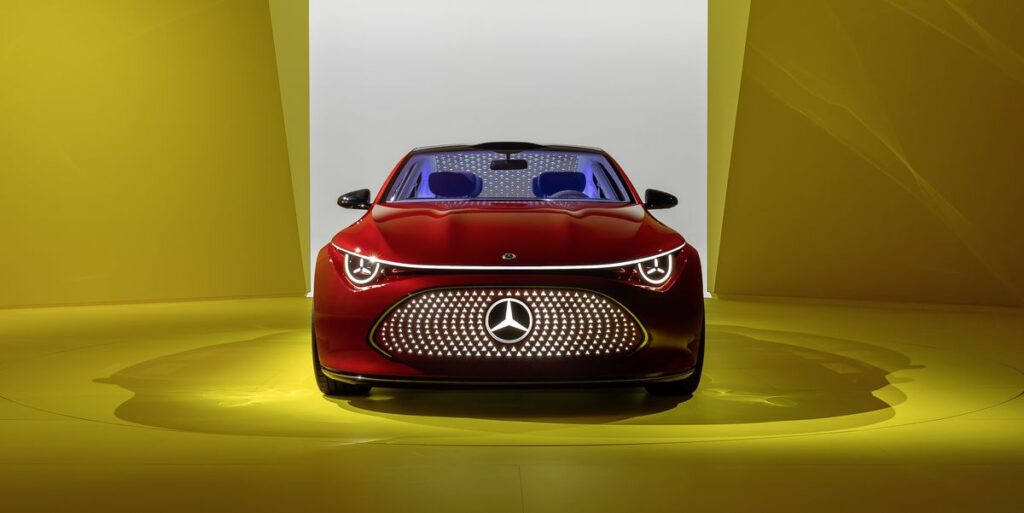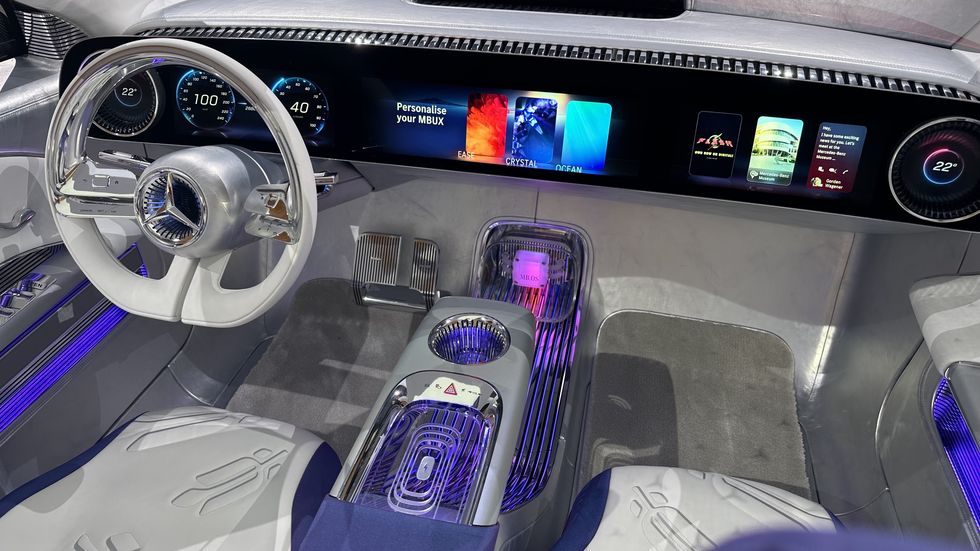Mercedes-Benz Concept CLA-Class Is a Long-Range EV Stunner

The Concept CLA-Class EV is an electric-first clean-sheet design that’s about the same length as the current CLA sedan. Its rear-mounted motor, two-speed transmission, and 800-volt architecture should deliver better efficiency than current EVs, enabling some 400 miles of range. Many trickle-down features from the Vision EQXX concept are present, including the cabin-spanning MBUX Superscreen.
Mercedes-Benz took the wraps off the Concept CLA-Class electric vehicle in Munich today. The existing product nomenclature and remarks characterizing it as “close to production” suggest that elements seen here will appear in the upcoming full redesign of the CLA.
Production of the new electric luxury car will commence in late 2024, according to representatives, which suggests the final product will be the 2025 Mercedes-Benz CLA in the U.S. market. Three other spinoffs will follow: a wagon variant we likely won’t get, and a pair of SUVs that may become the GLA and GLB replacements.
The concept is an “electric first” clean-sheet design utilizing the new Mercedes-Benz Modular Architecture (MMA) that was conceived to support entry-level EVs, and it does appear exactly as you might expect a next-generation CLA-class to look, albeit with numerous concept-car flourishes. Its approximate 185-inch length (no specific dimensions were given, but the designer admitted to that much) is about the same as the current CLA, which measures 184.6 inches. The concept features a broad stance and six-spoke 21-inch wheels, shod with 255/35R-21 front and 285/30R-21 rear tires. Design highlights include a beautifully sculpted shark nose with a prominent undercut, and smooth flanks with a flowing Coke-bottle shape. Its hood is also quite long for an EV, and that’s because they plan to offer ICE engines, too.
Power Details
The EV will be offered in single-motor rear-drive and dual-motor all-wheel drive variants, but Mercedes was not ready to tell us if the ICE cars will be front-drivers like the current CLA or use rear drive like the EV concept. In the Concept CLA Class that was shown, power comes from a single rear-mounted permanent magnet synchronous motor that makes 235-hp, using MB.EDU (Mercedes-Benz Electric Drive Unit) technology from the Vision EQXX concept that requires “close to zero percent” rare-earth materials. Eschewing the usual direct-drive setup, its output flows through a two-speed transmission that enables better efficiency over a wider range of speeds. The motor and battery also employ 800-volt architecture in another major nod toward efficiency. The concept also features a next-generation heat pump that not only conveys powertrain heat to the cabin, it also extracts heat from the outside air like a household heat-pump, even in winter.
Impressive-Seeming Range
The few performance specs that were revealed underscore the payoff: an estimated range of 750 km and consumption pegged at an ultra-low 12 kWh per 100 kilometers on Europe’s WLTP test cycle. In more familiar EPA terms, our translation suggests 400 miles of range and efficiency approaching 150 MPGe. What’s more, the 800-volt architecture allows DC fast-charging at 250 kW, which could allow some 200 miles of range (in U.S. reckoning) to be added in 15 minutes. Mercedes did not share the battery size, but the same calculations used to make the above estimates suggest that 90.0 kWh of usable capacity is likely. The tracks with the car’s proportions, which features a wide stance, a longer wheelbase, and shorter overhangs than the current CLA but is still a compact machine compared to, say, a Lucid Air.
As it turns out, two different lithium-ion battery chemistries will be offered. The pricier option, which no doubt produces the long range of the concept, features anodes with silicon-oxide content that improve energy density. The entry-level version will use lithium-iron phosphate, a less costly option that will likely result in a battery with a lower kWh rating and less range. Still, with some 400 miles at the top end, it’s likely to be a compelling number.
That Superscreen
An EQXX-inspired MBUX Superscreen dominates the interior because it is the de facto dashboard that spans the entire cabin. The instruments and infotainment sub-screens occupy their usual places, but the panel continues uninterrupted to the passenger side, where your companion can theoretically (specific US features aren’t yet clear) watch movies, control the audio system, export navigation routes to the driver, and more. It’s powered by MB.OS chip-to-cloud architecture that knits all of the electronic features of the car together, creating what Mercedes says will be a unique user interface and user experience. We’re dubious, because the concept had few physical controls and the system only operated in a demo mode that made it impossible to evaluate. But there’s no avoiding the MB.OS chip itself, because it is housed on the floor beneath the Superscreen in a luminous water-cooled housing that looks like a Flux Capacitor from Back to the Future. Yeah, that probably won’t happen.
Dan Edmunds|Car and Driver

Dan Edmunds|Car and Driver
Other interior features of the concept are also unlikely to see the light of day, such as the starry-night roof that’s engraved with hundreds of three-pointed stars. That roof also lacks any kind of obvious tint, and there’s no structural crossmember aft of the windshield header. The one-piece four-place bucket seats are also unlikely, and there’s more silver-hued leather on the floor (and firewall!) than we’ve seen in our entire lives. But it’s easy to see past all that and imagine a more production-ready configuration, with a tinted glass roof bolstered by an additional crossmember, along with conventional-looking seats and trim. More physical switchgear would be appreciated, too.
That may be why we especially like the large protruding rotary climate dials near either end of the Superscreen, which you grasp and rotate to adjust the temperature, with the readout embedded in their centers. But the air doesn’t emerge from them; it passes out through slots embedded in a secondary dash behind the floating screen. Those vents are slotted to mimic the lamella structures on the undersides of mushrooms, and that design theme permeates the interior. Lamella-inspired ribbing makes up the speaker grilles, the cupholder lining, the horn button detailing, and the anti-skid basement floor below the floating console.
Level 3 Automation Ready?
There is one other unique design feature that has a strong chance of making it to production, and that is the subtle transverse blister atop the roof just above the windshield. This rounded hump houses sensors that Mercedes says will enable Level 3 automated driving at some point during the car’s production life. That capability won’t be introduced at launch, but the presence of the sensors and the OTA updatability of the MB.OS-powered control software make it likely that the next CLA will be, as one representative put it, “Level 3-ready.”
More details pertaining to the actual CLA production car will arrive in the coming months, but if you subtract the most fanciful design details, you’re still left with a stunning-looking CLA concept with impressive mechanicals that enable stellar consumption, range, and charging capabilities. What do you lose with the entry-level battery? How much power will the AWD version make? What about the gas engine versions? More to the point: what will it cost? That information is months away, but the CLA class does occupy the lower rungs of Mercedes-Benz’s price ladder. Mercedes is moving their EV offerings into much-appreciated territory.
This content is imported from poll. You may be able to find the same content in another format, or you may be able to find more information, at their web site.

Technical Editor
Dan Edmunds was born into the world of automobiles, but not how you might think. His father was a retired racing driver who opened Autoresearch, a race-car-building shop, where Dan cut his teeth as a metal fabricator. Engineering school followed, then SCCA Showroom Stock racing, and that combination landed him suspension development jobs at two different automakers. His writing career began when he was picked up by Edmunds.com (no relation) to build a testing department.





